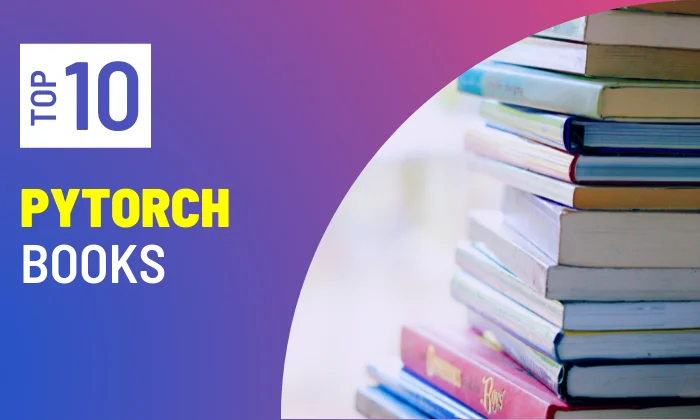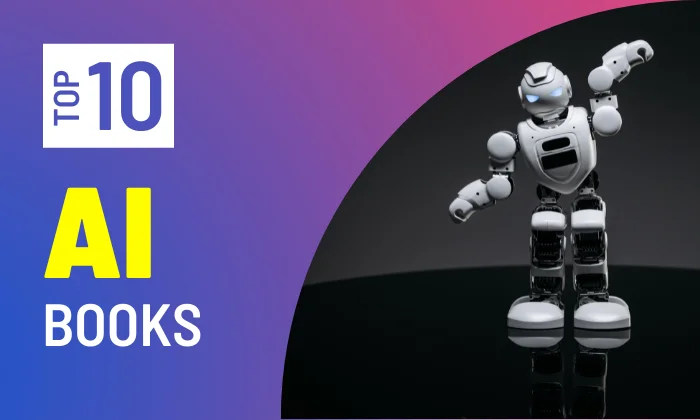These are the top 10 PyTorch books that will help you learn and implement PyTorch.

1. Deep Learning for Coders with Fastai and PyTorch: AI Applications Without a PhD 1st Edition
by Jeremy Howard, Sylvain Gugger
Deep learning is sometimes thought to be the sole domain of math PhDs and huge tech firms. However, as this hands-on guide reveals, Python programmers with limited math expertise, modest quantities of data, and minimum code may produce excellent results in deep learning. The Fastai is the first ever library in PyTorch to give the world the first ever consistent interface in deep learning applications. The authors of this book, the creators of Fastai, show you how to use Fastai and PyTorch to train a model for a variety of tasks. You’ll also dive deeper into deep learning theory to acquire a comprehensive knowledge of algorithms at work.
2. Deep Learning with PyTorch: Build, train, and tune neural networks using Python tools 1st Edition
by Eli Stevens, Luca Antiga, Thomas Viehmann
We get to know of new deep learning applications, such as improved medical imaging, accurate credit card fraud detection, and long-term weather forecasting every now and then. PyTorch enables the programmer to control these supernatural abilities of programming.
PyTorch simplifies deep learning without compromising advanced capabilities and is instantly familiar to anyone who knows Python data tools like NumPy and Scikit-learn. It’s ideal for quickly creating models, and it scales well from laptop to business. This hands-on guide gets you started on developing a tumor image classifier from the ground up right away. Following the basics, you’ll study best practices for the whole deep learning pipeline before moving on to more complicated projects as your PyTorch abilities improve.
3. Mastering PyTorch: Build powerful neural network architectures using advanced PyTorch
by Ashish Ranjan Jha, Dr. Gopinath Pillai (Foreword)
The AI revolution is being driven by deep learning, and PyTorch is making it easier than ever to construct deep learning applications. This PyTorch book will teach you how to use expert approaches to extract the most information from your data and construct complicated neural network models. The book begins with a basic review of PyTorch before delving into picture classification using convolutional neural network architectures. As you go, you’ll use generative models to apply deep learning to a variety of domains, including music, text, and image generation, and you’ll learn about generative adversarial networks. You’ll be able to use PyTorch to conduct sophisticated deep-learning tasks and develop effective artificial intelligence models by the end of this PyTorch book.
4. PyTorch Pocket Reference: Building and Deploying Deep Learning Models 1st Edition
by Joe Papa
One of the most popular frameworks for deep learning research and development is at your fingertips with this brief, easy-to-use guide. To help you write faster and spend less time looking for solutions, the Author provides direct access to syntax, design patterns, and code examples.
PyTorch code covers every step of neural network construction, from importing data to designing training loops to model optimization, for research scientists, machine learning engineers, and software developers. Learn how to quickly deploy your code to production on AWS, Google Cloud, or Azure, as well as how to deploy your machine learning models to mobile and edge devices.
5. Programming PyTorch for Deep Learning: Creating and Deploying Deep Learning Applications
by Ian Pointer
If you want to master deep learning then this book is perfect for that step. Machine learning technology is rapidly changing the world around us. Throughout this hands-on guide, you’ll learn how to use Facebook’s open-source PyTorch framework to get up to speed on important concepts and develop the skills you’ll need to build your neural networks.
By delving deeply into each aspect, the author guides you through the creation of neural networks that facilitate operations on images, sound, text, and more. He also goes over how to apply transfer learning to photos, debug models, and use PyTorch in a production setting.
6. Natural Language Processing with PyTorch: Build Intelligent Language Applications Using Deep Learning
by Delip Rao, Brian McMahan
Natural Language Processing opens up a world of possibilities for artificial intelligence problems, allowing technologies like Amazon Alexa and Google Translate to exist. This practical guide explains to you how to use these methods using PyTorch, a Python-based deep learning package if you’re a developer or data scientist new to the language processing discipline and deep learning.
The authors provide you with a solid foundation in natural language processing and deep learning methods and show you how to utilize PyTorch to create applications with rich text representations that are tailored to your challenges. There are various code examples and pictures in each chapter.
7. Modern Computer Vision with PyTorch: Explore deep learning concepts and implement over 50 real-world image applications
by V Kishore Ayyadevara, Yeshwanth Reddy
You’ll start by creating a neural network from scratch with NumPy and PyTorch, then learn how to tune its hyper-parameters using best practices. You’ll then use convolutional neural networks and transfer learning to do picture categorization and learn how they function. As you learn about auto-encoders and current generative adversarial networks, the book will show you how to swap facial expressions, generate new faces, and manipulate facial expressions. You’ll learn how to create OCR, picture captioning, object detection, and a self-driving car agent by combining CV with NLP techniques like LSTM and transformer, as well as RL approaches like Deep Q-learning. By the end of this book, you’ll be able to successfully tackle over 50 real-world CV issues using recent NN architectures.
8. Deep Learning from Scratch: Building with Python from First Principles
by Seth Weidman
For machine learning practitioners and even many software engineers, deep learning has become indispensable. For data scientists and software developers with machine learning knowledge, this book gives a complete introduction. You’ll begin with the fundamentals of deep learning and quickly get to the intricacies of crucial advanced architectures, building everything from the ground up. The author uses a first-principles method to demonstrate how neural networks work. From the ground up, you’ll learn how to use multi-layer neural networks, convolutional neural networks, and recurrent neural networks. You’ll be set up for success on any future deep learning projects if you have a full understanding of how neural networks work mathematically, computationally, and conceptually.
9. Make Your First GAN With PyTorch
by Tariq Rashid
A simple introduction to Generative Adversarial Networks, as well as a step-by-step explanation of how to create your own using PyTorch. This beginner-friendly book will provide you with hands-on experience by giving a platform full of PyTorch basics examples and codes. With GPU acceleration, the reader can build their first neural network. The conditional and convolutional GANs are also covered in depth in this guide, allowing readers to have a better knowledge of them. Students of machine learning will benefit from the appendices, which cover topics such as calculating optimum loss values for balanced GANs, and probability distributions, and sampling them to make images that are commonly glossed over in many courses.
10. Python Deep Learning: Exploring deep learning techniques and neural network architectures with PyTorch, Keras, and TensorFlow, 2nd Edition
by Ivan Vasilev, Daniel Slater, Gianmario Spacagna, Peter Roelants, Valentino Zocca
This Second Edition will introduce you to deep learning, its related neural networks, and how to train them using high-performance algorithms and popular Python frameworks. For satisfying current and future market demands, deep learning is more critical than ever. This book will introduce you to deep learning and teach you how to apply machine learning to your projects. You’ll also learn how to address computer vision, natural language processing (NLP), and speech recognition difficulties. To produce images, you’ll look at generative model approaches like variational autoencoders and Generative Adversarial Networks (GANs). By the end of the book, you’ll have a solid understanding of deep learning theory as well as its practical applications.
Stay tuned to AiHints for more insightful tutorials on web development, programming, and artificial intelligence. Happy coding!


